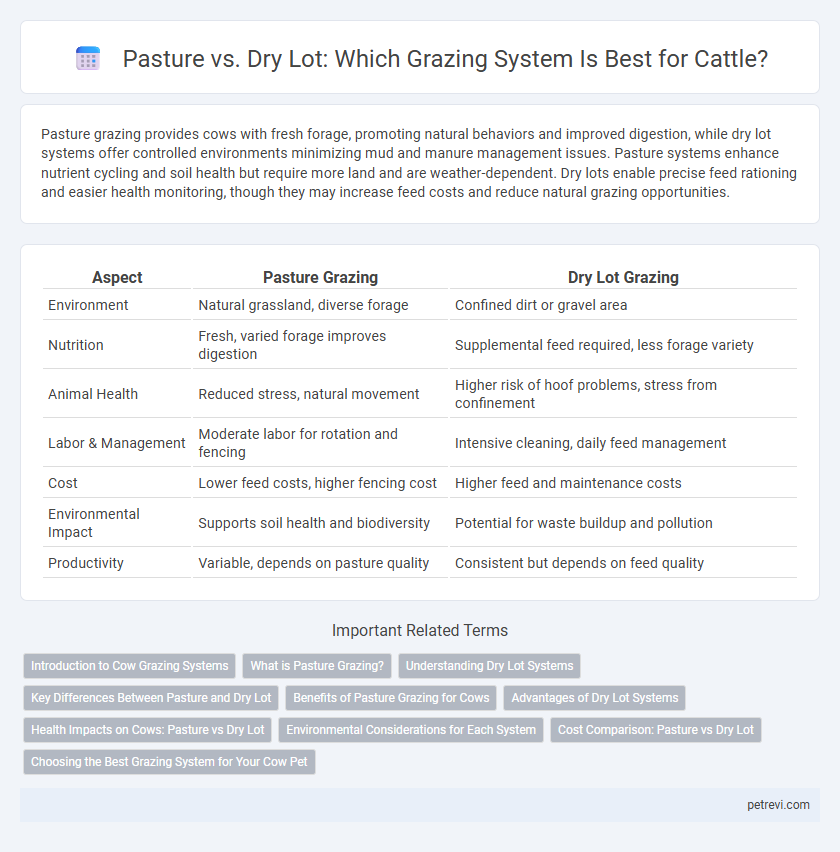Pasture grazing provides cows with fresh forage, promoting natural behaviors and improved digestion, while dry lot systems offer controlled environments minimizing mud and manure management issues. Pasture systems enhance nutrient cycling and soil health but require more land and are weather-dependent. Dry lots enable precise feed rationing and easier health monitoring, though they may increase feed costs and reduce natural grazing opportunities.
Table of Comparison
| Aspect | Pasture Grazing | Dry Lot Grazing |
|---|---|---|
| Environment | Natural grassland, diverse forage | Confined dirt or gravel area |
| Nutrition | Fresh, varied forage improves digestion | Supplemental feed required, less forage variety |
| Animal Health | Reduced stress, natural movement | Higher risk of hoof problems, stress from confinement |
| Labor & Management | Moderate labor for rotation and fencing | Intensive cleaning, daily feed management |
| Cost | Lower feed costs, higher fencing cost | Higher feed and maintenance costs |
| Environmental Impact | Supports soil health and biodiversity | Potential for waste buildup and pollution |
| Productivity | Variable, depends on pasture quality | Consistent but depends on feed quality |
Introduction to Cow Grazing Systems
Pasture grazing systems provide cows with natural forage, promoting healthier digestion and higher milk quality by allowing access to diverse grasses and plants. Dry lot systems involve confined spaces with controlled feed, ensuring consistent nutrient intake but often limiting natural behaviors and forage variety. Balancing pasture and dry lot systems can optimize cow health, productivity, and farm sustainability by combining natural grazing benefits with precise feed management.
What is Pasture Grazing?
Pasture grazing for cows involves allowing cattle to feed directly on growing grasses and legumes in open fields, promoting natural foraging behavior and improving animal health. This system enhances soil fertility through manure distribution and supports sustainable land use by maintaining vegetation cover. Compared to dry lot systems, pasture grazing reduces feed costs and increases milk quality by providing fresher, more nutritious forage.
Understanding Dry Lot Systems
Dry lot systems for cows involve confining livestock on a designated area with minimal vegetation, providing controlled feeding and reducing grazing pressure on pastures. This method enhances soil preservation and manages manure more effectively compared to pasture grazing, which can lead to overgrazing and soil compaction. Properly managed dry lots improve cow health by optimizing nutrition and reducing exposure to parasites commonly found in pasture environments.
Key Differences Between Pasture and Dry Lot
Pasture grazing systems provide cows with natural forage, promoting better animal health through diverse nutrient intake and increased exercise, while dry lots rely on stored feed and limit mobility. Pastures improve soil fertility and reduce feed costs by utilizing regenerative grazing practices, whereas dry lots require more intensive manure management due to concentrated waste. Pasture-based systems support sustainable land use and better animal welfare, contrasting with dry lots that offer controlled feeding but higher environmental and management demands.
Benefits of Pasture Grazing for Cows
Pasture grazing provides cows with access to fresh, nutrient-rich forage that enhances digestion and overall health. This natural grazing system promotes increased exercise and reduced stress, resulting in improved milk production and better weight gain. Compared to dry lot systems, pasture grazing supports environmental sustainability through soil fertility and biodiversity maintenance.
Advantages of Dry Lot Systems
Dry lot systems for cow grazing offer precise control over feed intake and nutrient management, leading to improved animal health and production efficiency. These systems reduce pasture degradation and soil erosion by minimizing overgrazing and concentrate manure, facilitating better nutrient recycling. Enhanced protection from adverse weather conditions and reduced parasite exposure further contribute to livestock welfare in dry lot environments.
Health Impacts on Cows: Pasture vs Dry Lot
Pasture grazing provides cows with fresh forage that supports better digestive health and reduces the risk of lameness due to softer ground surfaces. Dry lot systems often expose cows to harder, compacted ground that can increase hoof problems and stress-related illnesses. Access to pasture also promotes natural behaviors and improved immune function compared to confined dry lot environments.
Environmental Considerations for Each System
Pasture grazing systems promote soil health by enhancing carbon sequestration, reducing erosion, and supporting biodiversity through diverse plant species. Dry lot systems concentrate manure, which can lead to nutrient runoff and groundwater contamination if not managed properly, posing greater risks to local water quality. Implementing rotational grazing on pasture lands mitigates overgrazing and maintains ecosystem balance, whereas dry lots require careful waste management to minimize environmental impact.
Cost Comparison: Pasture vs Dry Lot
Pasture grazing systems typically incur lower costs due to reduced feed expenses and less need for manure management compared to dry lot systems. Dry lot systems often require significant investments in feed, bedding, and waste handling infrastructure, increasing overall operational costs. Considering feed savings and natural forage availability, pasture grazing proves more cost-effective for cow nutrition and maintenance.
Choosing the Best Grazing System for Your Cow Pet
Pasture grazing provides cows with natural forage, promoting better digestion and overall health by allowing access to diverse grasses and nutrients. Dry lot systems offer controlled feeding and reduce exposure to parasites, but may limit movement and natural behaviors. Selecting the optimal grazing system depends on balancing cow welfare, nutritional needs, and land resources.
Pasture vs Dry lot for Cow grazing system Infographic

 petrevi.com
petrevi.com